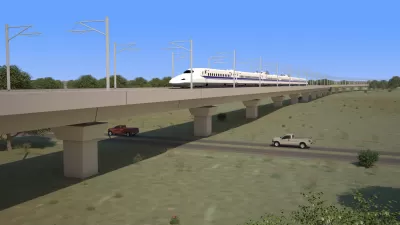A report commissioned by Texas Central Partners is the first to calculate the potential economic benefit of a proposed privately developed high-speed rail connection between Houston and Dallas.

Brandon Formby reports on the results of a study by Texas Central Partners about the potential economic benefit of a high-speed rail connection between Dallas and Houston. According to the study, as reported by Formby, "the project will spur $36 billion in economic benefits over 25 years – and will pour hundreds of millions of dollars into government coffers each year."
The private development of the project will bring unique benefits to public revenues. "Because Texas Central is a private company, its property and infrastructure is taxable, unlike tax-funded rail lines or highways. That means the company will have to pay property taxes to cities, school districts and counties for the entire length of its track between the two metropolitan areas. Those rural counties between the two cities is home to several people who oppose the project," explains Formby. In all, the report expects Texas Central to pay $2.5 billion in taxes by 2040.
The article also includes soundbites offered by Kyle Workman, president of Texans Against High-Speed Rail. Workman says the study overlooks the loss of property value on land taken along the route.
The article also includes more about forthcoming decisions about station locations.
Texas Central Partners hired Insight Research Group, based in Allen, Texas, to complete the study.
FULL STORY: Study: High-speed rail would spur billions in economic benefits

Maui's Vacation Rental Debate Turns Ugly
Verbal attacks, misinformation campaigns and fistfights plague a high-stakes debate to convert thousands of vacation rentals into long-term housing.

Planetizen Federal Action Tracker
A weekly monitor of how Trump’s orders and actions are impacting planners and planning in America.

San Francisco Suspends Traffic Calming Amidst Record Deaths
Citing “a challenging fiscal landscape,” the city will cease the program on the heels of 42 traffic deaths, including 24 pedestrians.

Defunct Pittsburgh Power Plant to Become Residential Tower
A decommissioned steam heat plant will be redeveloped into almost 100 affordable housing units.

Trump Prompts Restructuring of Transportation Research Board in “Unprecedented Overreach”
The TRB has eliminated more than half of its committees including those focused on climate, equity, and cities.

Amtrak Rolls Out New Orleans to Alabama “Mardi Gras” Train
The new service will operate morning and evening departures between Mobile and New Orleans.
Urban Design for Planners 1: Software Tools
This six-course series explores essential urban design concepts using open source software and equips planners with the tools they need to participate fully in the urban design process.
Planning for Universal Design
Learn the tools for implementing Universal Design in planning regulations.
Heyer Gruel & Associates PA
JM Goldson LLC
Custer County Colorado
City of Camden Redevelopment Agency
City of Astoria
Transportation Research & Education Center (TREC) at Portland State University
Jefferson Parish Government
Camden Redevelopment Agency
City of Claremont





























